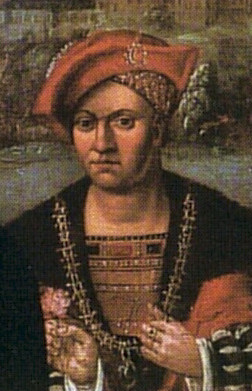Top Qs
Timeline
Chat
Perspective
John II, Duke of Cleves
Duke of Cleves, a state of the Holy Roman Empire From Wikipedia, the free encyclopedia
Remove ads
John II, "The Babymaker", Duke of Cleves, Count of Mark, (German: Johann II. "der Kindermacher", Herzog von Kleve, Graf von Mark) (13 April 1458 – 15 March 1521) was a son of John I, Duke of Cleves and Elizabeth of Nevers.[1] He ruled Cleves from 1481 to his death in 1521. He was called "The Babymaker" as he had fathered sixty-three illegitimate children[2] prior to his marriage with Mathilde of Hesse in 1489.

Pope Innocent VIII awarded John the Golden Rose of Virtue on 15 April 1489. This is remarkable in light of the fact that John, with his alleged 63 illegitimate children, had the dubious reputation of being a "child maker". From then on, John called himself "Johann von Kleve, Count of La Marck and Katzenelnbogen".
Remove ads
Marriage and issue
John married Matilda of Hesse,[3] daughter of Henry III, Landgrave of Upper Hesse and Anna of Katzenelnbogen,[4] on 3 November 1489 in Soest. They had:
- John (1490–1539), succeeded as Duke of Cleves and Count of the Marck[5]
- Anna (1495–1567), married in 1518 with count Philip III of Waldeck-Eisenberg[5]
- Adolf (1498–1525), appointed by his father's cousin Philip of Cleves, Lord of Ravenstein and Wijnendale, as his successor, but died before Philip did in 1528
With Catherine de Chaumont:
- Hermann of Cleves seigneur d'Afnois, d'Amazy and Saligny (1458-1532), married Leonarde Perreau,[6] legitimized in 1506.[6]
With unknown mothers:
- Helena (or Hedwig) of Cleves (1480-?), married Otto van Büren
- Joos (Judocus) of Cleves (1485-1541)
- Wilhelm of Cleves (c. 1495 -?)
- Marten of Cleves
- Hendrik of Cleves
- Katharina of Cleves,[7] married Johann von Asschebroick[7] and secondly Johann von Loe
- Elisabeth of Cleves, married Gobert van Bemmel
- Dietrich of Cleves (?-1493)[7]
- Johann of Cleves[7]
- Adolf of Cleves, married Agnes von Hessen zu Hulhausen
- Coat-of-arms of
La Mark - Coat-of-arms of
Cleves
Remove ads
Ancestry
Remove ads
References
Sources
External links
Wikiwand - on
Seamless Wikipedia browsing. On steroids.
Remove ads



